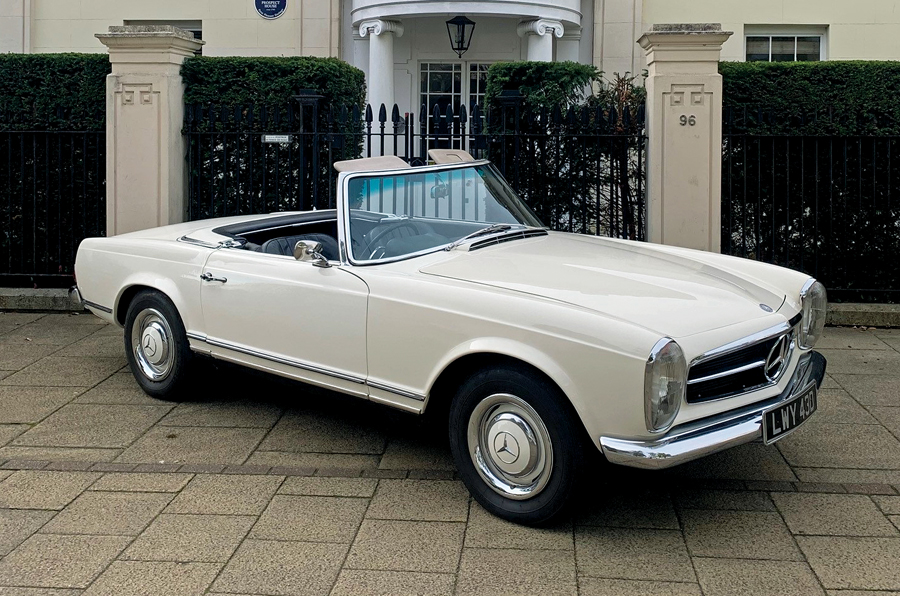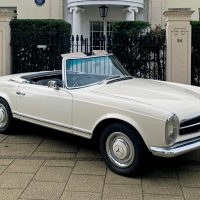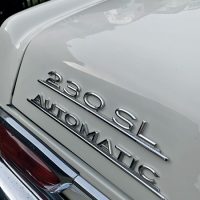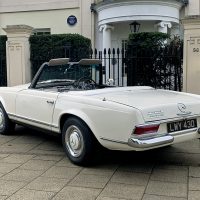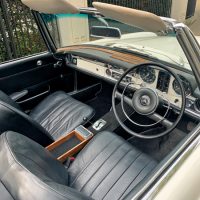SCM Analysis
Detailing
| Vehicle: | 1966 Mercedes-Benz 230SL Convertible |
| Years Produced: | 1963–67 |
| Original List Price: | $7,500–$7,900 in 1964 |
| SCM Valuation: | $56,500 |
| Chassis Number Location: | On right side of firewall |
| Engine Number Location: | On driver’s side of engine block, below number 5 and 6 spark plug |
| Club Info: | International Pagoda SL Group |
| Website: | http://www.sl113.org |
| Alternatives: | 1962–68 Alfa Romeo 2600, 1964½–66 Ford Mustang, 1961–66 Fiat 1500/1600 cabriolet |
| Investment Grade: | B |
This car, Lot 217, sold for $89,456, including buyer’s premium, at Bonhams’ Hendon, U.K., auction on November 21, 2019.
This sale is a wonderful example of the differences between the American Mercedes market and the British Mercedes market. Entry into the Pagoda market is much cheaper in the United States than it is in the U.K.
The cheapest Pagoda you can buy
I frequently counsel Pagoda owners who are looking at these cars but are unclear about where the market stands.
Often discouraged by the high prices of subpar 280SLs, these individuals approach me looking at other options. If you absolutely have to have a W113 — but don’t have $85,000 burning a hole in your pocket — you can opt for a 230SL.
In fact, there is even a $30,000 option. This is usually a 230SL or 250SL, frequently an automatic and usually in somewhat tatty but usable condition. Often, they are European-market cars with poorly repaired rust, but that hardly matters when you’re humming along at 4,000 rpm. That sounds a lot more exciting than spending two and a half times that much on a 280SL, doesn’t it?
But Americans are picky. To most of us, it’s the 280SL — or no Pagoda at all.
It’s all the same to the British
Our friends in the British Isles are not as picky. The model distinctions are less important, and a Pagoda is simply a Pagoda.
The American ideal — a 1971 manual-transmission 280SL — doesn’t matter as much as whether the car is a factory right-hand-drive specimen. While the 280SL will always be preferable to some degree, the British market will readily pay a significant premium for a right-hand- drive car. In fact, if I were to offer a correctly restored, U.S.-market 1971 manual 280SL at an auction in the U.K. and a sorted, but humble, right-hand-drive automatic 230SL alongside it, the 230SL would likely outperform the LHD example.
But if you’re looking at the W113 as your next purchase, the 230SL and 250SL are worthy of consideration. Are the British on to something?
The German Alfa Romeo
My friend Rob Bird, who is in the same line of work as I am, has nicknamed the 230SL the “German Alfa.” This title lauds the purity and simplicity of the original incarnation of the W113.
With its free-revving, five-main-bearing engine and spartan interior, even the automatic 230SL feels like a sports car. European-market versions of the 230 and 250 with manual gearboxes also featured a 3.75:1 rear-axle ratio, making them somewhat nicer to drive on the highway than a typical 280SL with 4.08:1 or 3.92:1 gearing, especially with their free-revving M127 engine.
Many enthusiasts who have a total understanding of what the Pagoda is harbor clandestine biases towards the 230 and 250SL — and might actually turn their nose up if offered a 280SL.
U.S. Pagoda market wants 280SLs
We Americans, however, frequently eschew purity for status, performance for comfort, subtle excellence for bragging rights and good value for potential profit.
Unsurprisingly, the 280SL dominates the U.S. Pagoda market, particularly the 1970 and ’71 models. This is the ultimate aspiration of the American Pagoda buyer, and it is usually followed by dozens of questions when a reasonable specimen is found.
To compound this, even the cars priced at the top of the market have considerable needs, such as worn differential mounts, leaking a/c systems, sloppy engine-bay errors and numerous liberties taken with structural repairs.
This differs heavily from what European buyers want, particularly when dealing with examples such as our subject car. Usually, less attention is paid to the model type. Instead, the car’s overall fit and finish is scrutinized first.
Here’s a summary of the two markets under scrutiny:
U.S. market: “We want 1970–71 280SLs, preferably with a/c, all of the spot welds and no brown or red cars.”
U.K. market: “We want solid Pagodas, but they must be right-hand drive.”
Status in the U.S.
In the U.S. market, the pecking order is as follows:
The top-tier Pagoda is a ’71 280SL produced in January or February of 1971. A manual gearbox and a/c are added bonuses.
Next would be a ’71 produced in late 1970.
And, of course, after that, any 1970 model (produced from August of 1969 and later). 1968 and ’69 280SLs are lumped into the same category, with manuals being slightly more desirable.
American-market cars are preferred over European-market cars as well.
A good deal for true Pagoda fans
As a result of this market hierarchy, many dollars are flushed away on W113s that might be newer and better equipped — but are fraught with mechanical and cosmetic errors that go unnoticed because American buyers will shell out significantly more money for what they perceive to be a more-desirable car.
Like it or not, the 1970–71 280SL still drives the market. The only more valuable Pagoda is the 280SL with the ZF 5-speed, which was discussed in SCM’s January 2018 issue (German Profile, p. 82).
In the U.S., 230 and 250SLs are relegated to the bottom of the totem pole, along with early (1968) automatic Euro-market 280SLs. This hierarchy makes them a good deal for someone who appreciates the Pagoda for what it is, and not for what wanna-be owners think.
Not a shocking sale in the U.K.
While our subject car might seem like an expensive Pagoda to U.S. buyers, in the U.K. this is market-correct for a right-hand-drive, solid, low-mileage 230SL.
If our subject car were offered in the U.S., $35k would have been all the money. If it had been a left-hand-drive car, maybe $49k would be possible. With falling Pagoda prices around the globe, this car had to be a high-quality example to sell for what it did.
The most logical explanation for its selling price is that the interested bidders inspected this example in person and found it to be an exceptional car with a superb restoration. I can’t say for sure, as engine-bay photos were not displayed on Bonhams’ website.
Outside of the U.K., this car would have been well sold. But in the insular British market, where labor rates are extremely high, solid RHD specimens are rare and subtlety is a virtue. This car was fairly bought and sold. ♦
(Introductory description courtesy of Bonhams.)
